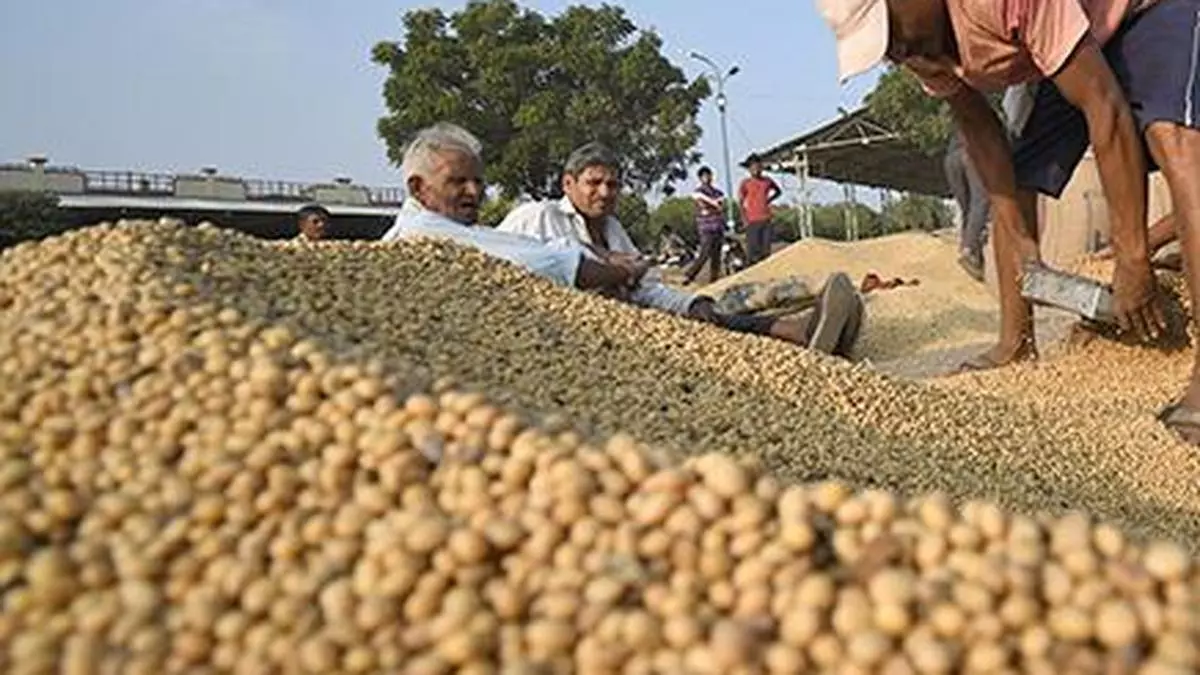Maharashtra farmers seek Government intervention as soyabean prices plunge
Maharashtra’s soybean farmers are grappling with falling prices, as market rates in several Agricultural Produce Market Committees (APMCs) have dropped below the Minimum Support Price (MSP) of ₹4,892 per quintal fixed by the Centre for the 2024-25 crop year. The State government has now urged the Centre to impose import duties on edible oil, soya milk and cake.
Despite the MSP being set ₹292 higher than the previous year’s ₹4,600 per quintal, current prices in APMC markets across the state range between ₹2,800 and ₹4,400 per quintal.
In Hinganghat, for instance, soyabean prices hit a low of ₹2,800 per quintal, while in Lasalgaon-Vinchur, it was ₹3,000. Though some markets, such as Latur, saw prices reach up to ₹4,799 per quintal, and Sangli peaked at ₹5,200, the modal price – the rate at which most trades take place – in many markets remains well below the MSP. The modal price has fluctuated between ₹4,000 and ₹4,600 per quintal, with markets like Latur reporting a rate of ₹4,650 and Amravati at ₹4,445.
State’s demand
The price drop has sparked concerns among farmers and prompted government intervention. State Agriculture Minister Dhananjay Munde said the Union Government had approved the opening of soyabean procurement centres in Maharashtra for 90 days to provide relief. “Under the Central Government’s MSP, soyabean will be procured at a minimum price of ₹4,892 per quintal, besides urad,” Munde said.
In addition to the procurement centres, Maharashtra is pressing the Centre to impose duties on imported edible oil, soya milk, and soya cake to support domestic prices. Munde said discussions are on with Union Agriculture Minister Shivraj Singh Chauhan on this issue. “There has also been a discussion…regarding imposing duties on the import of products such as edible oil, soya milk, and soya cake, as well as providing a subsidy of at least $50 per quintal for soybean exports. Once a positive decision is taken, soyabean farmers will receive additional financial benefits,” he said.
Maharashtra has seen a significant rise in soyabean cultivation this kharif season, with the area under cultivation expanding to 51.17 lakh hectares, surpassing the State’s average of 41.50 lakh hectares. This marks an increase from the previous season, when soyabeans were cultivated on 50.85 lakh hectares.
Drought-prone region
The Vidarbha and Marathwada regions hold the largest area under soyabean cultivation, with most of the farming being rain-fed. “Cotton and soyabean are the lifelines of Vidarbha and Marathwada. Even the smallest fluctuation in market prices can disrupt the entire economic cycle of this region,” says Pandurang Bande, a farmer in Latur district.
In addition to the market volatility, farmers in this drought-prone region have also been grappling with the challenges posed by unseasonal rains in recent years, which have further strained agricultural productivity. Unpredictable weather patterns and fluctuating crop prices have left many farmers struggling to recover from mounting financial losses.
With soyabean being a major cash crop, the pressure on farmers intensifies as they face uncertainty over weather conditions and market rates. Many are now calling for “greater” support from the government, including better price stabilisation mechanisms and compensation for weather-related losses, to safeguard their livelihoods and stabilise the region’s agricultural economy.
Farmers’ seek MSP
The Ministry of Agriculture informed the Lok Sabha last month that the MSP for soyabeans is determined based on recommendations from the Commission for Agricultural Costs and Prices (CACP). The CACP considers various factors such as cost of production, domestic and international prices, and a margin of at least 50 per cent over production costs. However, despite the MSP being set higher, market rates in Maharashtra continue to fluctuate, leaving farmers anxious as prices fall below the government-fixed support price.
In response to mounting pressure ahead of the upcoming State Assembly elections, the Dev Fadnavis government has announced a compensation of ₹5,000 per hectare for soyabean farmers who suffered losses last season. The government may consider taking a similar step for the second consecutive year to avoid potential backlash from the farming community.
In the 2021-22 season, soyabean prices reached record highs on cues from the international markets and rising soyabean oil prices. In some regions, prices soared to ₹9,000 per quintal, raising hopes among farmers for better returns.
However, prices fell short of expectations last year, leaving many farmers disappointed. Market experts attribute the current pressure on soyabean prices to increasing imports of edible oil, which has dampened domestic rates, and higher soyabean crop in the US and Brazil.
